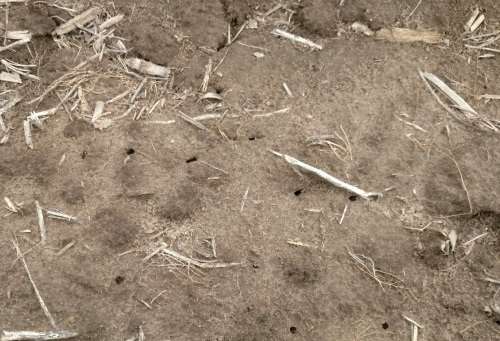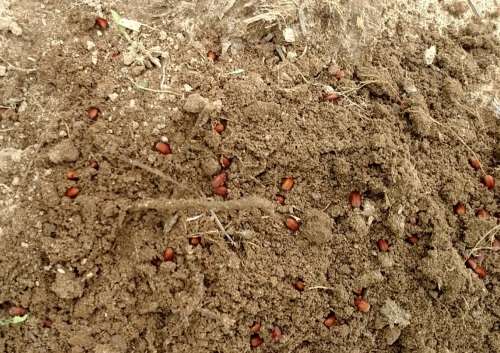
Numerous holes where adult Asiatic garden beetles exited the ground. Note how sandy this field is.
You may have Asiatic garden beetles and not even realize it. Bruce Mackellar, the Michigan State University Extension field crops educator in southwest Michigan, is in the worst-hit area. He has provided a list of Asiatic garden beetle signs in corn fields in his neighborhood.
- Look for patches of corn that are stunted or yellowing with no obvious cause, such as water logging or water stress. If the grub infestation is heavy, the damage will be obvious, with severe stunting or stand loss. The height difference may not be great; instead, the color of the corn will be lighter than other parts of the field. There may be purpling on the lower leaves.
- Look for emergence holes. Asiatic garden beetle grubs pupate underground and beetles emerge through small, round holes. A lot of holes mean significant numbers of beetles emerged from that area.
- If there is marestail in the area, pull a few of the plants and look for grubs or cinnamon-colored adult beetles. Check around the empty hole, as there may be additional Asiatic garden beetles in the soil.
Colleagues at Ohio State University have noted heavy Asiatic garden beetle grub infestations around marestail plants, and MacKellar found numerous adult beetles near marestail. Some of the plants he pulled up had 50 or more adult beetles hanging out under the soil surface near the roots.

Adult Asiatic garden beetles in the soil where a marestail plant was pulled up. Bruce MacKellar counted 50 under one plant.
Ohio State University and MSU entomologists are teaming up to answer some of the questions about Asiatic garden beetles. If we get funding, we will be able to survey dozens of fields in northern Ohio into southern Michigan, starting next spring.
Source: msu.edu